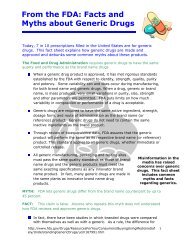Staying Connected: Technology Options for Older Adults - n4a
Staying Connected: Technology Options for Older Adults - n4a
Staying Connected: Technology Options for Older Adults - n4a
Create successful ePaper yourself
Turn your PDF publications into a flip-book with our unique Google optimized e-Paper software.
<strong>Staying</strong><br />
<strong>Connected</strong><br />
<strong>Technology</strong> <strong>Options</strong><br />
<strong>for</strong> <strong>Older</strong> <strong>Adults</strong>
<strong>Staying</strong> <strong>Connected</strong><br />
People of all ages are using the internet,<br />
cell phones and other technologies to<br />
communicate with family and friends<br />
in new and exciting ways. In a matter<br />
of seconds you can send a message<br />
to your son, receive a photo from your<br />
granddaughter or email an invitation<br />
to a family gathering. While younger<br />
people are typically the “experts”<br />
on these new resources, many older<br />
adults also utilize the internet, social<br />
media and cell phones to communicate<br />
and receive in<strong>for</strong>mation. These tools<br />
are an effective way to connect with<br />
your family, friends and community<br />
resources, particularly children and<br />
young adults.<br />
Many communities offer classes and other resources<br />
to help you get started with these new tools. To learn<br />
more about technology resources in your community,<br />
check with the following sources:<br />
■ Your local Area Agency on Aging — get connected by<br />
calling the Eldercare Locator at 800.677.1116 or visit<br />
www.eldercare.gov<br />
■ Libraries, schools and community colleges<br />
■ Family, friends and neighbors familiar with computers<br />
and cell phones
Text Messaging<br />
Text messaging or “texting” is sending brief<br />
messages via cell phones. Sending a “text”<br />
is a quick and easy way to stay in touch.<br />
Text messaging is especially popular with<br />
teens and young adults, which makes it an<br />
effective way to communicate with your<br />
children and/or grandchildren.<br />
How: In order to send a text message you<br />
must have a cell phone that has the text<br />
messaging feature. Each cell phone is<br />
different, so it is best to consult your manual<br />
to learn how to text on your phone. Here are<br />
some general “texting” instructions:<br />
•Access the main menu on your phone and<br />
select “message,” then select “create/new<br />
message.”<br />
•Using the letters on your keypad, enter<br />
a message (Note: some phones have<br />
a full keypad, similar to a computer or<br />
typewriter; other phones use the letters<br />
that correspond with each number on the<br />
phone).<br />
•Choose the recipient(s) of your text from<br />
your contact list or enter their phone<br />
number.<br />
•Press “OK” or “Send” to send your<br />
message.<br />
When to use: You might want to send a text<br />
if you have a short message/update that<br />
doesn’t garner a conversation. Texting is<br />
also useful when you or the recipient is in a<br />
quiet or noisy place where it is impossible<br />
to hold a conversation. On many cell phones<br />
you can send pictures along with your text<br />
or send messages to a group of people.<br />
Use text messaging <strong>for</strong> in<strong>for</strong>mal, casual<br />
communication with family and friends.<br />
Tips about privacy and safety:<br />
•Never respond to text messages from<br />
someone you do not know.<br />
•You may also receive SPAM via text<br />
message. Delete these messages.<br />
•Never text while driving.<br />
•Be cautious about sending your personal<br />
in<strong>for</strong>mation via text messages.<br />
The Cost of Texting: You could incur<br />
additional fees <strong>for</strong> texting. Check your cell<br />
phone plan <strong>for</strong> details.<br />
Texting Etiquette: When you text in all<br />
CAPS it is considered yelling or shouting.<br />
Avoid texting when having a face-to-face<br />
conversation. Be careful about tone — make<br />
messages straight<strong>for</strong>ward and clear. Set<br />
your phone to “vibrate” or “silent” when in<br />
quiet places.<br />
T9 — This function is on cell phones<br />
without full keypads. When you use T9<br />
it predicts what word you want to input<br />
based on the first letters typed, so you<br />
may not need to type the entire word.<br />
You can turn this function on or off.
Email<br />
Email stands <strong>for</strong> electronic mail. With email<br />
you can send messages from one computer<br />
to another. Email is like mail through the U.S.<br />
Postal Service that you receive daily, except<br />
you can send and receive email 24 hours a<br />
day, 7 days a week.<br />
How: Email users have a unique address<br />
(much like your home address) where you<br />
can send and receive messages, <strong>for</strong> example:<br />
john.smith76@yahoo.com. If you do not<br />
already have an email account, you can<br />
set up a free one on websites like:<br />
www.gmail.com, www.yahoo.com or<br />
www.hotmail.com. Click on “Sign-Up” or<br />
“Create Account” and follow the steps to<br />
create your email account.<br />
When to use: Many people like using email<br />
because messages are sent and received<br />
rapidly. You can send in<strong>for</strong>mation to one<br />
person or a group of people. Pictures and<br />
other documents can be attached to email<br />
messages.<br />
Tips about privacy and safety:<br />
•To access your email account you will need<br />
to create a password. Be sure to change<br />
your password often. Remember to write it<br />
down and keep it in a safe place.<br />
•Do not share your password.<br />
•Log out of your email account when you<br />
are done.<br />
•Only open attachments or click on links<br />
from people you know.<br />
•Do not open or reply to SPAM (see box).<br />
•Do not email your Social Security number,<br />
bank account number or other private<br />
in<strong>for</strong>mation.<br />
•Make sure your computer software and<br />
updates are current.<br />
Find additional email safety tips at<br />
www.wiredsafety.org and<br />
www.emailsafety.net.<br />
Email Etiquette: When sending email ALL<br />
CAPS is considered yelling or shouting. Limit<br />
<strong>for</strong>warding messages, list email addresses in<br />
the BCC (Blind Carbon Copy) line <strong>for</strong> large<br />
groups, use a descriptive subject line and<br />
utilize the spell check feature.<br />
SPAM — Unwanted email messages,<br />
frequently with commercial content,<br />
typically sent in large quantities to<br />
many email accounts. Many email<br />
accounts have SPAM filters to keep<br />
SPAM out of your inbox. Delete any<br />
messages that look suspicious.<br />
VIRUS — Small software programs<br />
designed to spread from one computer<br />
to another and interfere with computer<br />
operation. Viruses are often sent as<br />
email attachments. There are many<br />
virus protection programs available to<br />
keep your computer safe.
Facebook<br />
Facebook is a social networking service<br />
and website with hundreds of millions<br />
of active users worldwide. On Facebook<br />
you can create a personal profile page<br />
to connect with family members, add<br />
other users as “friends” and exchange<br />
messages. Additionally, you can join<br />
common interest groups organized by<br />
various characteristics.<br />
How: To create a profile page you must<br />
have an email address. Sign-on to<br />
www.facebook.com and fill in your<br />
in<strong>for</strong>mation to create the page. You<br />
then have the option to add photos and<br />
additional in<strong>for</strong>mation about yourself.<br />
When to use: Connect with your family,<br />
friends, organizations, causes and<br />
acquaintances all over the world. You can<br />
“friend” or “like” other users in order to<br />
follow their activity. Facebook makes it<br />
easy to send messages to grandchildren or<br />
organize a group of friends.<br />
Tips about privacy and safety:<br />
•Only become friends with people you know.<br />
•Do not list your home address or phone<br />
number.<br />
•Learn about the privacy settings that<br />
help you control what people see on your<br />
profile page at www.facebook.com/help.<br />
User Tips:<br />
•When someone posts a message or photo<br />
on your profile page you will receive an<br />
email.<br />
•The right hand column of your page is<br />
typically advertisements; avoid clicking<br />
these links.<br />
•You can search <strong>for</strong> organizations, groups<br />
and in<strong>for</strong>mation that interest you. Click<br />
the “like” button at the top of the page<br />
to receive automatic updates about their<br />
activities.<br />
•Only add photos, videos and content that<br />
you want others to see.<br />
•Search <strong>for</strong> friends through schools you<br />
attended, places you have worked and<br />
mutual friends.<br />
•You should use “messages” (similar to an<br />
email via your Facebook account) to send<br />
private notes to other Facebook users and<br />
“wall posts” (see box) <strong>for</strong> in<strong>for</strong>mation<br />
visible to all users.<br />
•Your “friends” can post photos of you on<br />
Facebook. If you do not want the photo<br />
on your profile page, delete it by clicking<br />
“remove tag” next to your name in the<br />
photo caption.<br />
Facebook Etiquette: Avoid constantly<br />
updating your status. Be aware of tone and<br />
use of sarcasm when posting.<br />
WALL POST — Each Facebook account<br />
has a “wall.” These are like community<br />
chalkboards where the account holder<br />
or their friends can post messages,<br />
links, videos or pictures.<br />
STATUS UPDATE — Messages users<br />
post on their profile page <strong>for</strong> their<br />
friends to read. Friends are also able to<br />
comment on or “like” the status.
Other Useful Connectors<br />
Skype allows you to make voice calls over<br />
the internet. You can make free calls to other<br />
Skype users. There is a fee <strong>for</strong> calls from<br />
Skype to telephones and cell phones. Skype<br />
is particularly popular <strong>for</strong> people making<br />
inexpensive/free international calls. You need<br />
a microphone and speakers/headset <strong>for</strong> your<br />
computer to use Skype (you can also place<br />
video calls if both users have web cameras).<br />
www.skype.com.<br />
Blog stands <strong>for</strong> “web log.” Often used like<br />
a public diary, a blog is a website or part of<br />
a website. Blogs are usually maintained by<br />
an individual and offer the opportunity <strong>for</strong><br />
followers to comment. Various websites<br />
offer free, easy-to-use blogs, such as:<br />
www.blogger.com, www.wordpress.com,<br />
www.livejournal.com.<br />
YouTube is a video-sharing website where<br />
you can view, upload and share videos.<br />
YouTube enables you to upload videos and<br />
share them with friends and other users.<br />
www.youtube.com.<br />
Instant Messaging (IM) is a <strong>for</strong>m of realtime,<br />
text-based communication that enables<br />
you to chat with another computer user. Both<br />
people must be on a computer at the same<br />
time to use IM. Many email providers have<br />
IM/chat features, such as: www.gmail.com,<br />
www.msn.com, www.aol.com.<br />
Twitter is a social networking website that<br />
enables you to post short, up-to-the-minute<br />
updates (known as Tweets) and follow<br />
others' Tweets, which are text posts of 140<br />
characters or less. Tweets are publicly visible.<br />
www.twitter.com.<br />
1-800-677-1116<br />
www.eldercare.gov<br />
www.facebook.com/eldercarelocator<br />
The Eldercare Locator is the first step to finding resources <strong>for</strong><br />
older adults in any U.S. community and a free national service<br />
funded by a grant from the U.S. Administration on Aging<br />
(AoA). The Eldercare Locator is administered by the National<br />
Association of Area Agencies on Aging (<strong>n4a</strong>).<br />
This publication was supported, in part, by a grant, No. 90AM3206, from the Administration on Aging, U.S.<br />
Department of Health and Human Services. Grantees undertaking projects under government sponsorship are<br />
encouraged to express freely their findings and conclusions. There<strong>for</strong>e, points of view or opinions do not necessarily<br />
represent official Administration on Aging policy.


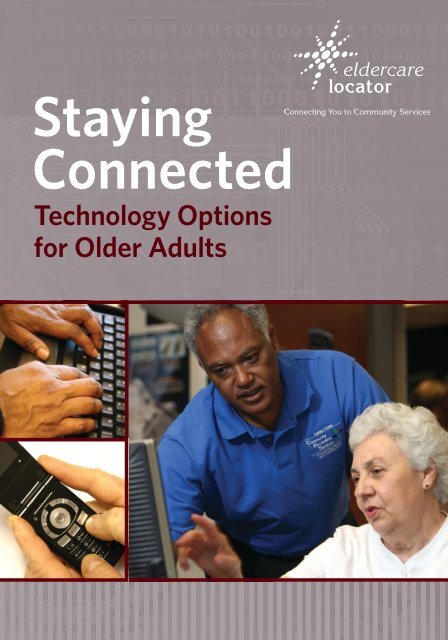
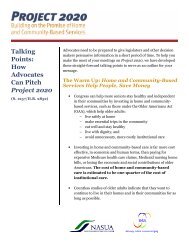

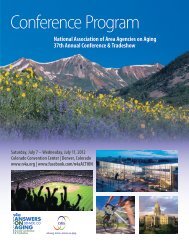


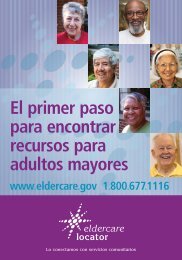
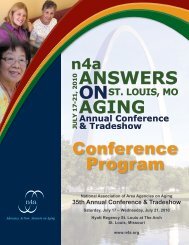
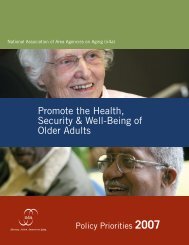
![Sample Letter to Super Committee [Date] The Honorable Patty ... - n4a](https://img.yumpu.com/28622426/1/190x245/sample-letter-to-super-committee-date-the-honorable-patty-n4a.jpg?quality=85)



